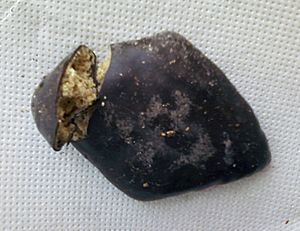Mustacciuoli facts for kids
 |
|
| Alternative names | Mustaccioli, Mostaccioli |
|---|---|
| Place of origin | Italy |
| Region or state | Naples Abruzzo |
| Main ingredients | Flour, almonds, chocolate, sugar, cloves, coffee, olive oil |
Mustacciuoli (say "moo-stah-CHOH-lee") are yummy traditional cookies from Naples, Italy. People usually enjoy these special treats around Christmas time. They are also called mustaccioli or mostaccioli.
Contents
What Are Mustacciuoli?
Mustacciuoli cookies have a special shape, like a flat, four-sided figure called a parallelogram. Imagine a rectangle that's been pushed a little sideways!
These cookies have a soft, cake-like inside. It's often spiced with flavors like cloves. The outside is usually covered in a delicious chocolate glaze.
Today, you can find many different kinds of mustacciuoli in Naples. Some have a white chocolate frosting instead of dark chocolate. Others might be covered in icing sugar and colorful candied fruit.
At Christmas, mustacciuoli are often sold with other famous Neapolitan sweets. These include Roccocò, raffiuoli, susamielli, and struffoli.
A Bit of History
Mustacciuoli have been around for a long time! These Neapolitan cookies were even mentioned by a famous cook named Bartolomeo Scappi. He was the personal chef for Pope Pius V way back in the 1500s. Scappi wrote about them as part of a big meal he prepared on October 18th.
How Did They Get Their Name?
The name mustacciuoli comes from an old Latin word, mustaceus. There are a few ideas about where this word came from:
- Some people think it comes from the Latin word mustum. This means "must," which is fresh grape juice. In ancient times, grape must was sometimes used as a sweetener in recipes.
- Another idea is that it comes from mustax, which is a type of laurel tree. Long ago, a cake called mustaceum was a wedding cake. It was wrapped in bay leaves (from the laurel tree) to give it a nice smell while baking.
Similar Sweets in Other Places
Mustacciuoli are not the only cookies like this in Italy. Other regions have their own versions:

